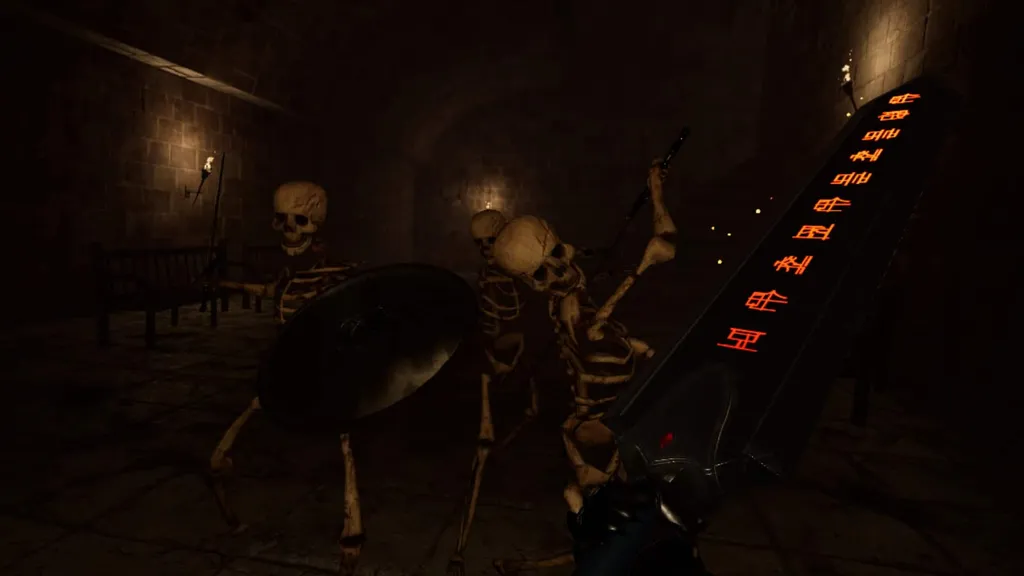Legendary Tales offers a winning mix of physics-driven combat and RPG depth. Read on for our Early Access impressions!
Legendary Tales would be worth a look had it just successfully taken the Blade & Sorcery formula and applied it to a linear dungeon crawler. The game’s physics-driven melee combat is incredibly impressive, offering familiar fun as you plunge swords into skulls and mash goblins with mallets. But it’s everything that developer Urban Wolf does on top of this that really makes this RPG newcomer one to watch.
On paper, the game ticks a lot of boxes. After a comically long tutorial (which goes as far as to essentially explain the very makeup of the RPG genre), you’ll build a character and then go on raids in search of more powerful gear, taking on increasingly powerful enemies. Randomly generated dungeons give you hours of exploration, character progression allows you to tailor a build to how you like to play and, yes, Urban Wolf might be the first to bring the joy of physics-driven VR to cooperative multiplayer.
Legendary Tales Gameplay
At the center of it all is weighty combat fueled by a unique blend of physicality and rulesets. Legendary Tales isn’t just about dominating mindless AI in a display of power; skeletons hit hard and you’ll die pretty quickly if you don’t learn to play by the rules. While you can hit an enemy on any part of its body for damage, your attacks will likely be blocked by swords unless you wait for an opening. The collision here is really impressive – striking your opponents sword will just see you bend your virtual wrist backward, while you can either stab, slash or even bludgeon enemies with a handle. You can simply block, but bringing your sword towards an attack will trigger a parry, allowing you to return fire with added damage. Each weapon will even specialize in one of those types of attacks so, while you can slash an enemy with a sword, you might find that stabbing gets you better results.
You’ll find a lot of variety in this system, thanks in part to how many different weapons there are. After spending two hours with the game I’ve wielded broadswords, throwing daggers, morningstars, clubs, two-handed blades, a bow and arrow, and there’s even the beginnings of a magic system to cast fireballs. Each weapon even has a unique ability, like visualizing weak points on enemies or stacking damage. Plus you can specialize in the weapon type you most prefer; the game’s progression system works by leveling up attributes as you employ them, so attacking with a sword will upgrade your strength, while a bow and arrow will increase your dexterity.
Still, we’re far from total realism here. Enemies will easily catch their blades on walls and other surfaces, making fights in some areas awkward. And, while the game’s physics are definitely impressive, they don’t feel quite as polished as some of its contemporaries, with hitboxes that have you brushing up against thin air and that oh-so-annoying VR-ism of the camera pushing you back when you try to lean over a chest to grab items.
Meanwhile, combat quickly descends into a hectic frenzy on stairs or when facing multiple foes and enemies insist on running circles around you, making it hard to keep track of them with a wired VR headset. The game’s combat would be more immersive if they didn’t force you to give chance all the time, or learned to attack in sequence with others to allow you to better manage the flow of battle. It’s also a little strange that skeletons are the base enemy for a game with convincing stabbing given that, y’know, they’re just a pile of bones.
But even with those caveats considered, there’s a surprising amount of depth to Legendary Tales. Some might prefer the entirely skill-dependent approach of Blade & Sorcery or Saints & Sinners, but this offers a compelling alternative for those that want a genuine sense of character progression and stat-driven depth. We’re still far from Skyrim or Dark Souls levels of complexity, of course, but the game goes deeper than a lot of other VR efforts. And that’s before we get into the co-op.
This is where Legendary Tales really shines and, given how quickly the difficulty can escalate in any given dungeon, how it was meant to be experienced too. Up to four players can journey together, giving the game a real sense of camaraderie. While enemies can’t focus on more than one player at a time, they’ll still overwhelm in numbers, forcing you to pick your battles first before whittling the herd down and focusing on more deadly foes together. Pick an enemy up and another player can knock their head off. Find a new weapon and you can simply toss your old one over to a friend for them to use instead. Though there are quirks, it’s natural elements like this that really enhance the experience.
A hugely promising start, then. I want to see more enemy variety in future updates to the game’s Early Access and it definitely needs some more dungeon themes to stave off the tedium of endlessly repeating corridors, but Legendary Tales already offers genuine depth, impressive physicality and one of the most enjoyable co-op experiences you’ll find in VR right now. We’ll have a full review when the game approaches its 1.0 launch, which is expected next year.
Legendary Tales is out now on Steam for $34.99. What do you make of the game? Let us know in the comments below!























